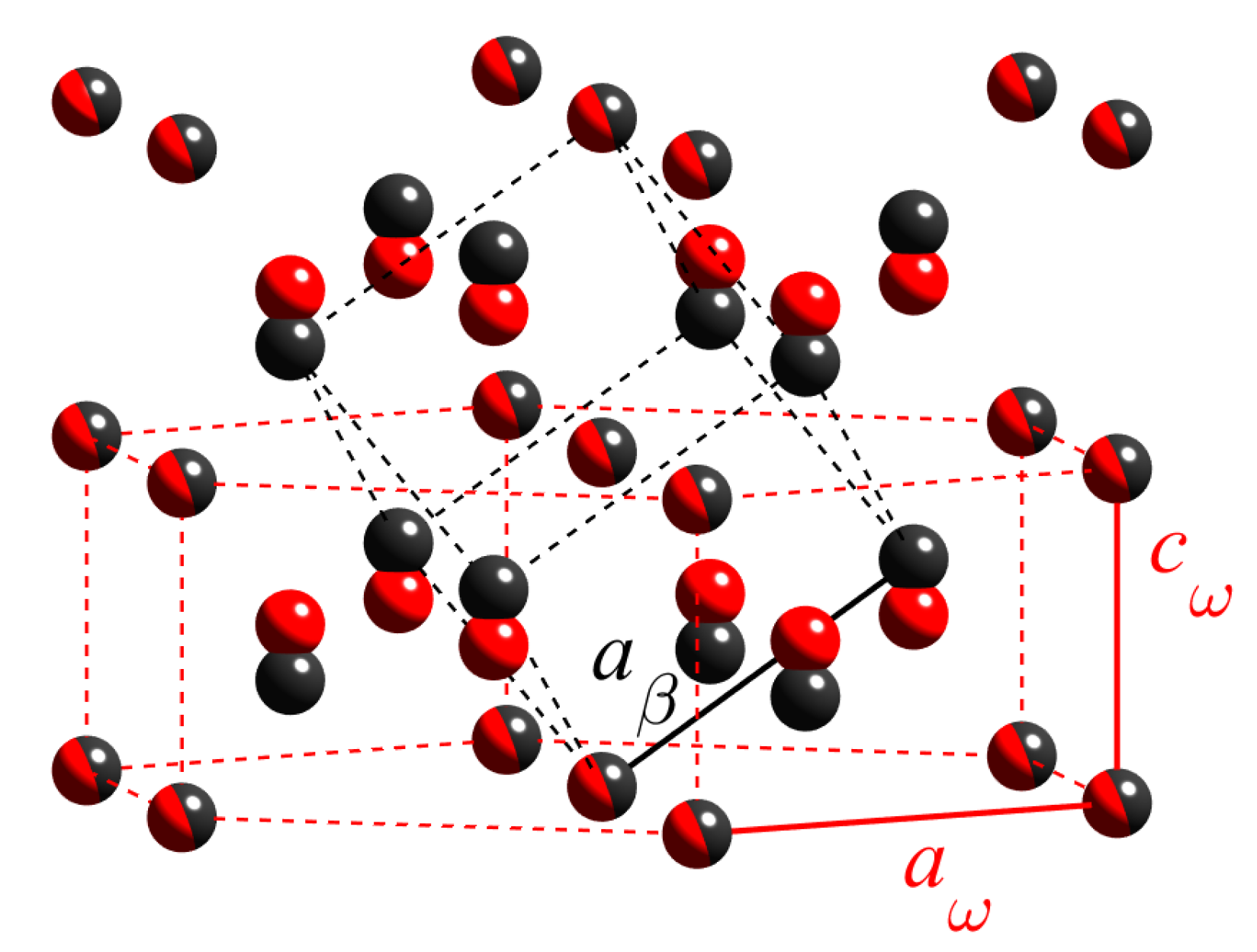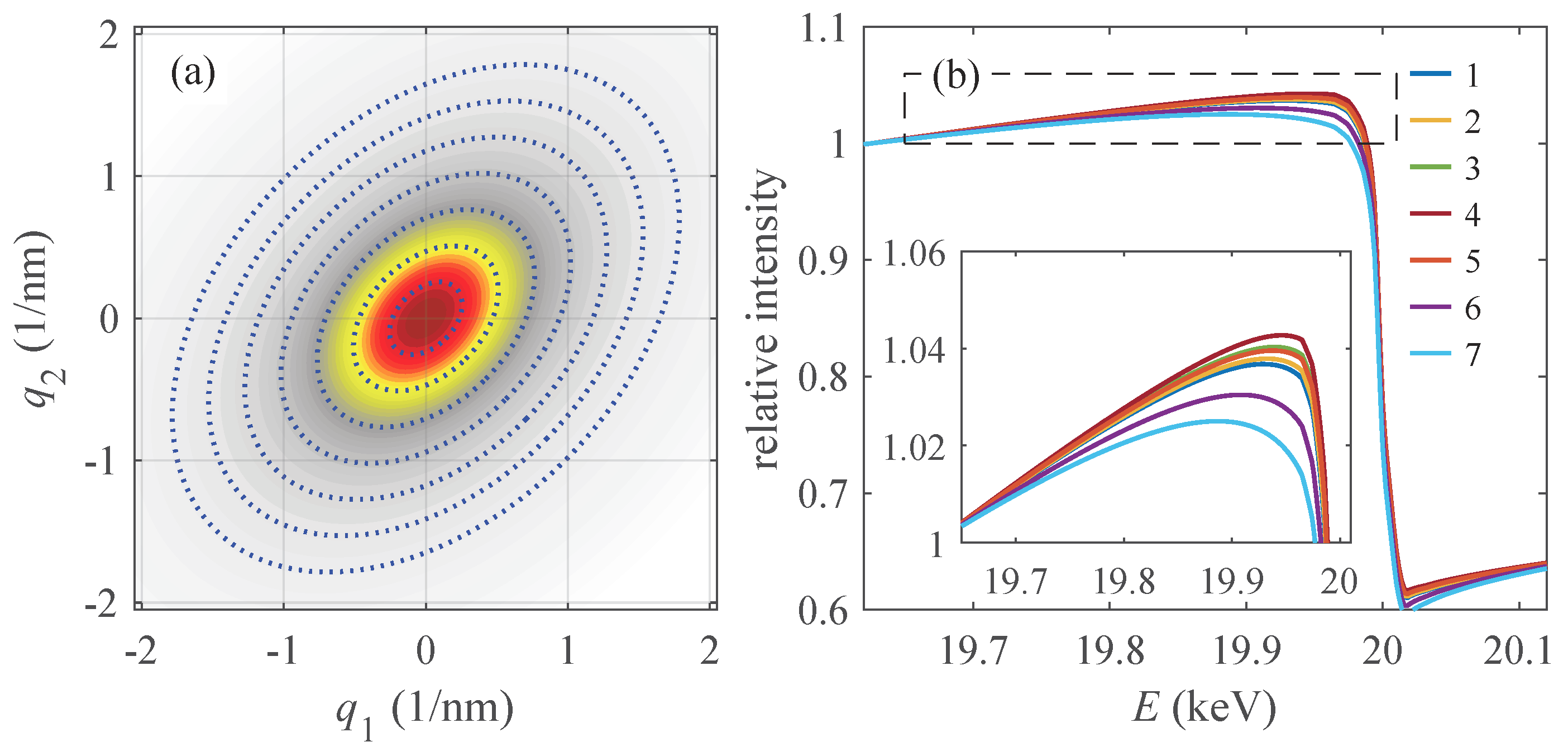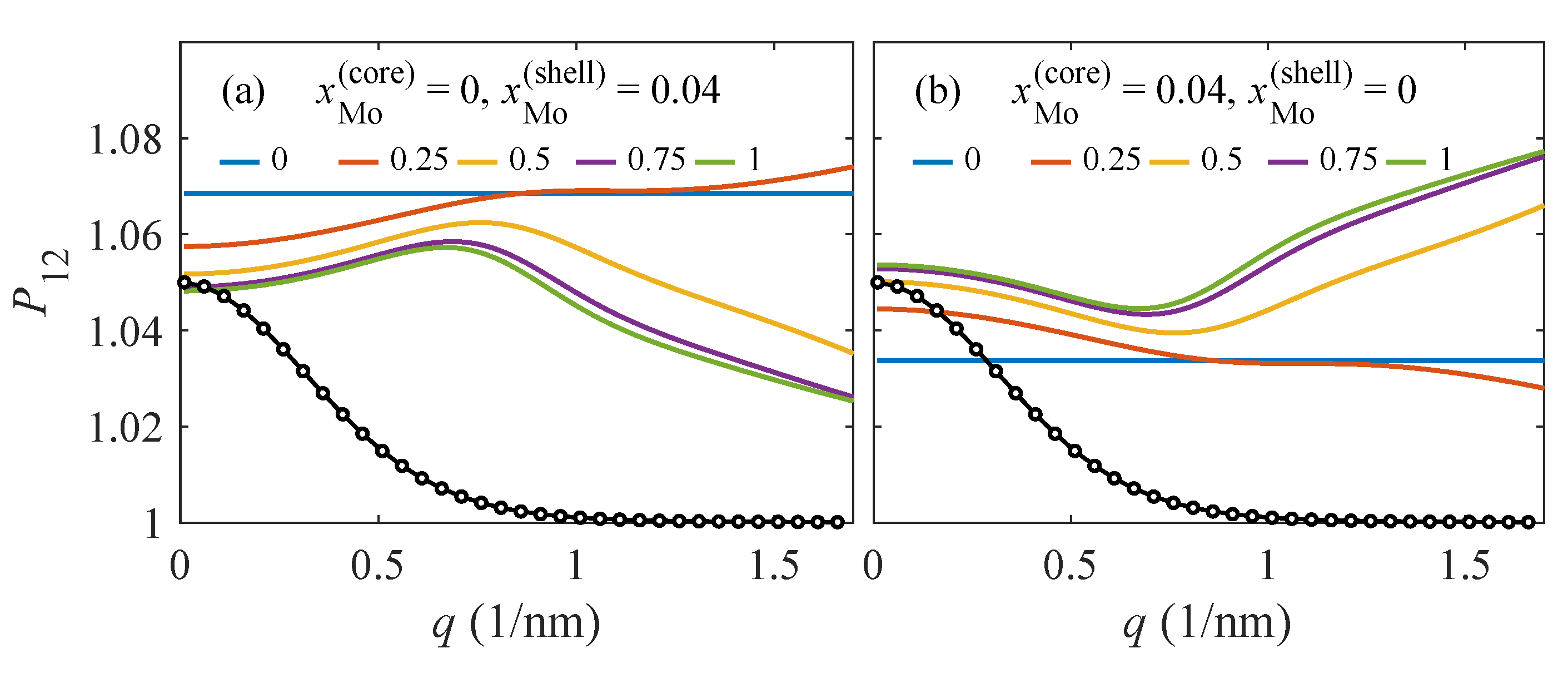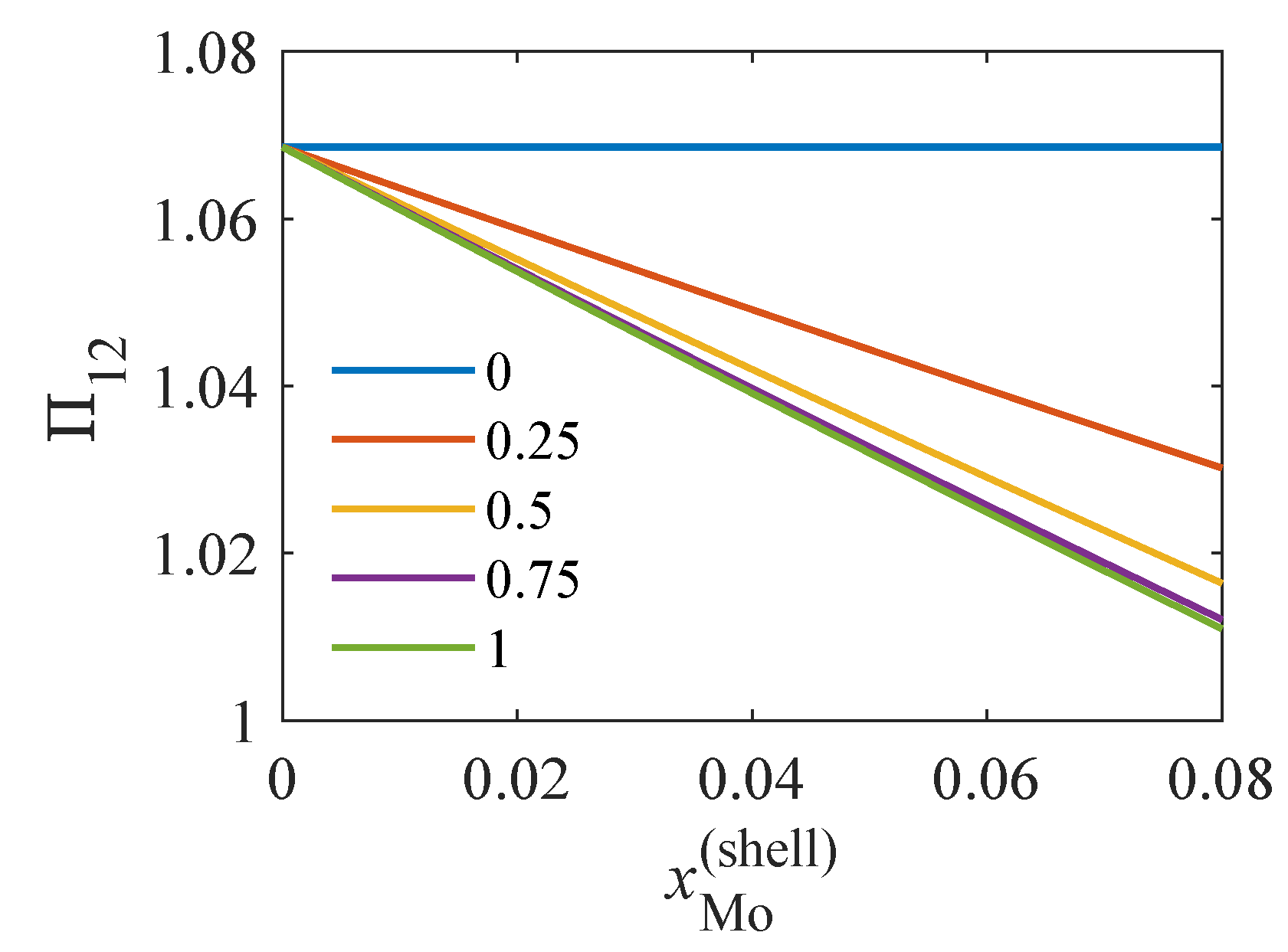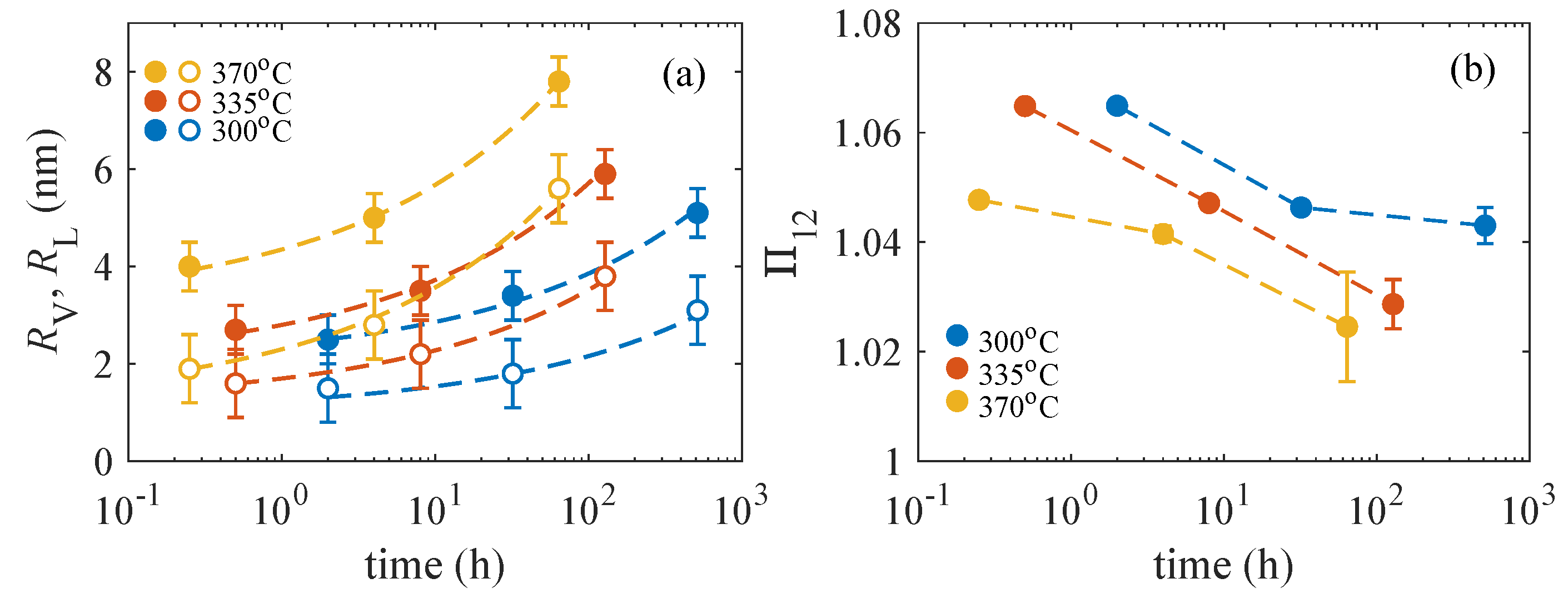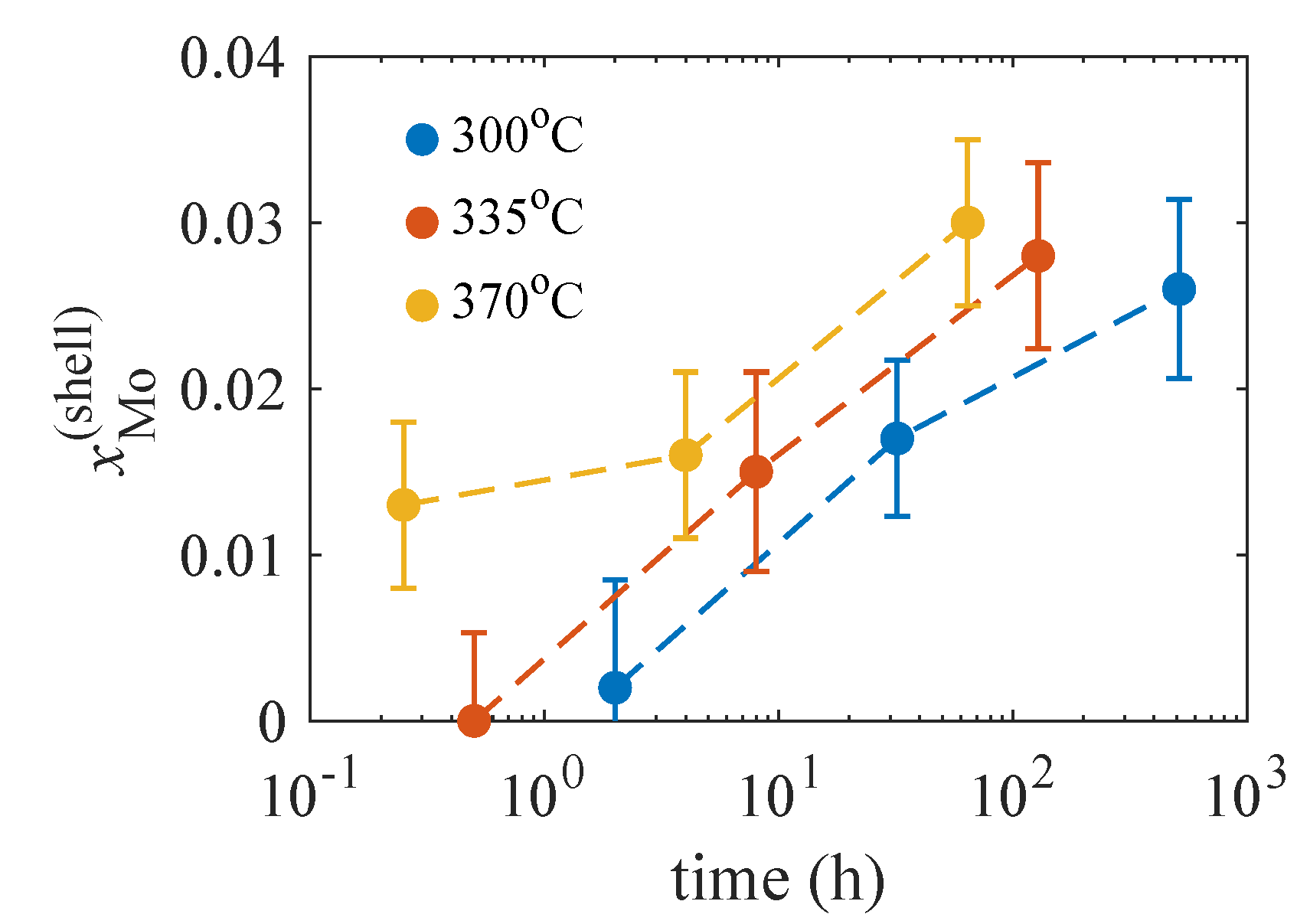1. Introduction
Nanoparticles of metastable
phase occur at a certain composition range in the metastable
alloys of Group IV elements, including important engineering alloys of Ti and Zr [
1]. These particles are either ellipsoidal in low misfit systems [
2,
3] or cuboidal in systems with a higher misfit [
4,
5]. The
particles are several tens of nanometers in size and homogeneously distributed throughout the parent
matrix. From a crystallographic viewpoint, the
particles have a hexagonal structure and are coherent with the body-centered cubic
matrix [
6]. It has been shown recently that the particles of the
phase are spontaneously ordered along
directions in the cubic
phase [
7].
Since its discovery by Frost et al. [
8], there has been a considerable interest in the
phase due to its influence on mechanical and superconducting properties of Ti and Zr alloys [
9,
10]. Until recently, it was widely believed that the formation of the
phase is a purely displacive transformation accomplished by the collapse of two neighboring (111)
planes and that in this stage the
particles have the same composition as the parent
matrix [
11]. The
transformation is sketched schematically in
Figure 1, where the atomic positions in the
and
phases are denoted by black and red spheres, respectively. The lattice parameter
of the body-centered
phase and the lattice parameters of the hexagonal
phase obey the formulas
However, Nag et al. gave an evidence of a mixed-mode transformation during which the structural as well as compositional instabilities play a role during
formation [
12]. During ageing, the
particles grow by a diffusion-assisted, displacement controlled process [
13].
There are still discussions regarding the chemical composition of the
particles and its evolution during thermal treatment. Hickman studied
formation in various Ti alloys including Ti-Mo systems and estimated the
phase composition from changes of its lattice parameter and volume fraction determined by transmission electron microscope [
14,
15]. One-dimensional atom probe was used to study the formation of the
particles in Ti–10V–2Fe–3Al (wt.%) alloy [
16]. More recently, three-dimensional atom-probe technique was used to investigate the composition of the
phase in Ti-Mo alloys [
3,
17], Ti–5Al–5Mo–5V–3Cr (wt.%) alloy [
18], Ti–5Al–5Mo–5V–2Cr–1Fe (wt.%) [
19]. From these studies it follows that the
phase tends to reject all alloying elements, including the
stabilizers such as Al. The rejected atoms of alloying elements create clouds around growing
particles. We studied this effect by small-angle X-ray scattering measured in-situ during ageing of Ti(Mo) single crystals; we determined the maximum Mo concentration in the cloud to be approximately 10–15% [
20].
In Ref. [
21], we showed that the
-Ti nanoparticles contain thin shell layers, in which the phase transformation
is not complete, and estimated the shell layer thickness to about 1 nm. In our previous paper [
22], we used anomalous X-ray diffraction (AXRD) for the study of Mo-rich “clouds” around the growing
-Ti nanoparticles [
23]. The method consists in measuring the energy dependence of the reciprocal-space distribution of X-ray intensity diffracted from the
-Ti matrix for the energies
E of the primary photons slightly below and above the MoK absorption edge
keV. AXRD experimental data are affected both by the radial profile of the Mo density in the cloud and by the local elastic strains around the nanoparticles so that their interpretation is not straightforward and must be supported by numerical simulations.
In this paper, we present the results of AXRD measurements on a selected diffraction peak in Ti-15wt.%Mo alloy. Using a detailed analysis of the pre-edge region of the AXRD spectra, we were able to determine the chemical composition of particles, since the AXRD signal is not affected by the structure and chemical composition of the -Ti matrix. We demonstrate that a shell layer at the particle/matrix interface contains a reasonable amount of Mo atoms. This method of determination of particle composition can be regarded as a precise technique complementary to other methods reviewed above.
2. Experiments
For the purpose of this experiment, oriented single crystals of Ti-15wt.%Mo alloy (corresponding to Ti-8at.%Mo) were grown using a floating zone technique; details of the growth procedure can be found in our previous papers [
24,
25]. Individual samples were solution-treated (ST) at 860
for 4 h in an evacuated quartz tube and quenched to water. Subsequently, different heat treated conditions were prepared by ageing in salt baths at temperatures 300
, 335
and 370
for times ranging from 15 min to 512 h. All heat treatments were terminated by water quenching. The aged samples were polished using SiC papers; final polishing was done on a vibratory polisher employing
and
alumina suspensions and
colloidal silica.
The anomalous X-ray diffraction (AXRD) experiments were carried out on a dedicated anomalous X-ray scattering and diffraction beamline BM02 at ESRF, Grenoble, France. The measured energies were near the Mo K absorption edge ( keV) in the energy range of 19.6–20.6 keV. The Ti K absorption edge at approximately 4.96 keV is useless, since the corresponding AXRD signal were hardly sensitive to the presence of Mo atoms. The sample was mounted on a kappa geometry diffractometer; the primary as well as the diffracted beam were in evacuated flight tubes in order to minimize the influence of scattering by air. The diffracted intensity was detected by a two-dimensional pixel detector IMXPAD S70. We acquired the images of the diffraction maximum of the hexagonal lattice for the energies from the above mentioned range with the energy step of 2 eV. We chose this diffraction maximum since it does not coincide with any diffraction peak of the phase and it was easily accessible in the used diffraction geometry and sample orientation.
As an example, in
Figure 2a, we show one detector image of the diffraction maximum of the sample aged at 370
for 64 h taken at 19.96 keV. The axes of the image are the orthogonal components
of the reciprocal-space vector
parallel to the detector plane,
are the wave vectors of the primary and scattered X-rays,
is the reciprocal-lattice vector (diffraction vector).
The elliptical shape of the maximum is caused by the ellipsoidal particle shapes, the half-axes of the iso-intensity ellipses are inversely proportional to the half-axes of the particle ellipsoids and depend also on the orientation of the ellipsoid axes with respect to the detector plane [
21,
22].
From the numerical simulations of the AXRD spectra described below, it follows that the AXRD spectra are the same in all points in reciprocal space lying on an iso-intensity contour. To assess the profile of the Mo density in the particles, we define regions of interest (ROIs) in the detector plane from which we extract the AXRD spectra. We chose elliptical ROI boundaries, with the ratios of the axes identical to those of the elliptical iso-intensity contours. In
Figure 2a, the ROI boundaries are depicted by blue dotted ellipses; the ROIs are the regions between two subsequent boundaries.
Figure 2b displays the AXRD spectrum taken from the whole intensity maximum, i.e., the sum of the signals of all ROIs (blue line), and the fluorescence signal (red), measured in the same setup tilting the sample away from a diffraction maximum. Tiny oscillations on both curves are caused by the absorption fine-structure effects (EXAFS and XANES) as well as by DAFS (diffraction anomalous fine structure); we ignore these oscillations in this paper.
In
Figure 3, we plot the AXRD spectra of individual ROIs of sample 370
/64 h after subtraction of the fluorescence background. The spectra are normalized to their values at
keV. The inset shows the details of the spectra just below
; it is obvious that the spectra differ indeed, and their differences are larger than the experimental data noise. The ROIs are defined in
Figure 2a, the parameter of the curves is the ROI number, ROI#1 is inside the smallest ellipse, ROI#16 is between the largest and second largest ellipses. Note that the outer ROIs are larger than the inner ones, which reduces slightly statistical fluctuations of the quite weak signals from the outer ROIs.
Figure 4 presents the details of the AXRD spectra just below
of all investigated samples; the spectra were obtained as sums of the diffracted signal over the whole detector window, corrected to the fluorescence. Similar to the previous figure, the intensities were normalized to their values at
keV. The tendency is obvious: with increasing ageing time the AXRD intensity below
decreases. Unfortunately, very small diffracted intensities for samples aged at 300
and 335
did not allow us to analyze the AXRD spectra from individual ROIs and only total integrated intensities of these samples could be investigated instead.
3. Simulation of AXRD Spectra
Since the heoretical description of AXRD effect in
-Ti nanoparticles is presented in detail in our previous paper [
22], here we show only a short overview. In contrast to the previous study, where we investigated the AXRD in the
-Ti matrix, here we completely neglect inhomogeneous deformation in the very small volumes of the
-Ti nanoparticles, which makes the whole theoretical description much simpler. Then, the AXRD intensity obeys the formula
where the averaging
is performed over particle sizes;
is a energy-dependent pre-factor containing the polarization factor, irradiated sample surface, and the primary intensity; its energy dependence can be approximated by a smooth polynomial function;
n is the density of the particles;
is the energy dependent linear absorption coefficient of the matrix material; and
is proportional to the penetration depth of the incoming radiation. The linear absorption coefficient depends on the Mo concentration
in the host material, and exhibits a steep increase at
. The particle shape factor is defined as the Fourier transformation of the position- and energy-dependent structure factor of the
-Ti lattice
:
the Fourier integral is calculated over the particle volume
.
In the following, we consider particles having the form of uniaxial ellipsoids, the rotation axis of which being
. We denote
the mean particle radii perpendicular and parallel to the rotation axis, respectively (“lateral” and “vertical” radii). In agreement with Ref. [
21], we assume a thin shell at the particle/matrix interface, in which the
transition is not complete. The shell structure is characterized by its thickness
, the Mo concentration
, and by the parameter
describing the completeness of the
transition (
and
correspond to
and
phases, respectively). Our general model of the particle includes also Mo atoms in the particle cores with the concentration
. The structure factor of the pure
-Ti phase in the particle core is a product of the weighted atomic scattering factor of the Ti(Mo) alloy in the core with the sum of the phase factors of the atoms in the elementary unit cell of the
phase
The structure factor of the shell is expressed as a weighted sum of the structure factors of the
and
phases:
In Equations (5) and (6), we denote
the position vectors of the atoms in the elementary unit cell of the
and
phases, respectively. The values of the atomic scattering factors
including the
E-dependent Hönl dispersion corrections have been taken from Refs. [
26,
27].
Figure 5 presents examples of the simulation results.
Figure 5a shows the detector image simulated for the diffraction maximum
on ellipsoidal nanoparticles with the mean radii
nm and
nm. The particle sizes are random and we consider Gamma distribution of the radii with the relative root-mean-square (rms) deviation of
%. We choose ellipsoidal ROIs; their boundaries are indicated in
Figure 5a by blue dotted lines.
Figure 5b shows the AXRD spectra taken from the ROIs, ROI#1 corresponds to the smallest ellipse in
Figure 5a. The spectra are normalized to their values at 19.6 keV; the EXAFS/DAFS oscillations above
are not included in the simulation. In the AXRD simulations, we used the Mo concentrations
,
, and
; the degree of completeness of the
transformation in the shell was
; and the shell thickness
nm. It follows from the results in
Figure 5 that the AXRD spectra differ especially in the energy region below the absorption edge
. We repeated the simulations for
and various values of parameter
p; in these cases, the normalized AXRD signals from different ROIs are identical.
To quantify the influence of the Mo concentration in the non-complete shell on the AXRD spectra, we calculated the dependence of the ratio of the intensities
at energies
keV (far below
) and
keV (the energy for which the ROI signal is most sensitive to the Mo content). For spherical particles,
depends only on the length
q of the reciprocal-space vector
and not on its direction. In the case of ellipsoidal particles, the
curve calculated for a fixed direction
of
depends only on
, where
is the radius of the particle in this direction.
Figure 6 shows the
q-dependences of the ratio
calculated for Mo atoms in the shell (
Figure 6a) and in the core (
Figure 6b). In the simulation, we used the values
nm, and
nm; the latter is consistent with our experimental finding in Ref. [
21]. If
, the ratio does not depend on
q.
From the results in
Figure 6, it follows that the shape of the
q-dependence of
is decisive for small
q, for which the diffracted intensity is large enough (the black dots in
Figure 6). Namely, if the
increases and decreases with
q, the Mo atoms are present mainly in the shell and core, respectively. This behavior is valid for any value of the completeness parameter
p. For larger
q,
depends on
p as well, however the corresponding intensities are very weak and the
values could be determined from measured data only with large experimental errors.
Similarly, we define the ratio of the integrated intensities
linearly decreases with increasing
(see
Figure 7).
4. Results
From the detector images (see
Figure 2a as an example), we determined the particle radii
using a simple ellipsoidal model [
24], and the results are plotted in
Figure 8a. The particle radii are between 2 and 8 nm; these data are in agreement with the results of X-ray small-angle scattering in Refs. [
7,
20], as well as with transmission electron microscopy [
22]. From the shape of the diffraction maximum, we were also able to roughly estimate the relative rms deviation of the radii to
%; however, this parameter has almost no influence on the resulting values of
. It is worth noting that the particles grow according to the
-dependence (
t is the ageing time), according to the Lifhshitz, Slyozov and Wagner growth model (LSW) [
28,
29].
In
Figure 8b, we plot the dependence of the ratio
of the integrated intensities on the ageing time
t and temperature
T (parameter of the curves). With increasing
t and/or
T, the ratio
decreases with regard to
Figure 7, which means that the effective value of
increases.
Good quality of experimental data made it possible to determine the
q-dependent intensity ratio
of samples aged at 370
.
Figure 9 compares the measured ratios (black dots) with the simulations performed for various
p values (parameters of the color curves). The black dots represent individual ROIs; their coordinate
q corresponds to the mean value of
q measured in the direction of the longer axes of the ROIs. For the simulations, we used the radii
determined above; we set
, and
in
Figure 9a–c, respectively. These concentration values yield a relatively better match to the experimental data (see
Section 5 for details). Following Šmilauerová et al. [
21], we used the shell layer thickness of
nm.
5. Discussion
Figure 8b shows a surprising effect, namely a decrease of the ratio
of the integrated intensities during ageing. A simple explanation of this fact could be an increase of the Mo concentration in the
nanoparticles; however, in the light of the
values in
Figure 9, this conclusion is misleading. The ratio
depends on an
effective concentration, which is affected also by
p and
. Therefore, a simple interpretation of
is not possible and additional information must be included in order to understand the
values.
The q-dependent ratio sheds light on this problem. From the qualitative behavior of for small q, for which the ROI signal is strong enough, one can distinguish Mo atoms in the shell from Mo atoms in the particle core; in the former case, increases with q, while, in the latter case, it decreases. This behavior does not depend on the completeness factor p; however, the effect is pronounced only if the total number of Mo atoms in the particle is large enough. From the curve, one can also estimate the value of , however only if the shell layer thickness is known with sufficient accuracy.
In sample 370
/64 h, the ratio
obviously increases with increasing
q (
Figure 9a), therefore the Mo density in the shell is larger than in the core. Moreover, in our previous work [
21], we estimated the shell thickness to
nm and the completeness factor
in all samples of the 370
series. Using these additional results and putting
, we obtained
in sample 370
/64 h. In the other samples of the 370
series, the
q-dependence of
was not distinct enough. Nevertheless, keeping
, we could estimate the Mo concentrations in the shell to
and
for samples aged at 4 h and 15 min, respectively. These results suggest that the Mo concentration in the shell layer slightly increases during ageing.
In the 300
and 335
sample series, the diffracted intensity is weak and the values of
suffer from errors up to 100%, even if we increase the ROI sizes, so that in these samples we could determine only
with reasonable accuracy. However, using the
values determined above,
and
p from our previous work [
21], and assuming
, we could estimate
; the results along with those for the 370
series are plotted in
Figure 10. The tendency of the increase of
is obvious in all sample series; however, the numerical values for the 300
and 335
samples must be handled with care, since they are based only on
.
The AXRD method presented here can also be used for other chemically non-homogeneous nanoparticles; the form of the function for small q is characteristic for the presence of a shell with a different chemical composition. The minimum ROI size and consequently the q-resolution of is limited by signal fluctuations, which increase with decreasing ROI size. If the diffracted intensity is not sufficient, which is the case for very small particles, only the integrated ratio can be determined. In this case, for the determination of the chemical composition of the shell, a priori information on the composition of the core region must be used.
